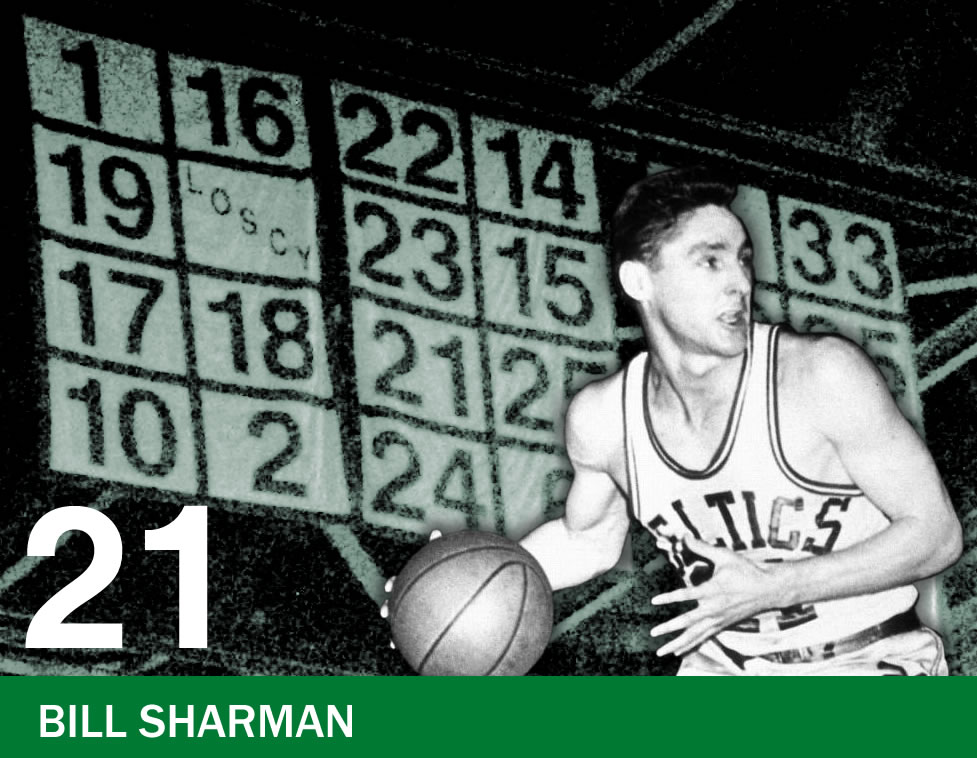From now until February 11, Red’s Army will be posting stories about the players behind the Celtics’ 22 retired numbers and that one retired nickname. Stories will be posted in the order that the numbers were retired.
In 1972 Jerry West finally won a championship.
Bill Russell had retired three years back, and the Celtics were only just getting things figured out under Tommy Heinsohn and a novel small ball run-and-gun approach to the game (at least it was novel for the NBA–the ABA was all about that kind of stuff).
The Lakers won 33 games in a row that year. That is, in an era when players flew commercial, and coach, an incredible single-season achievement. In context I would easily consider it more impressive than the Warriors’ single season win total that year they lost to the Cavs in the Finals.
And just why am I talking up the Lakers on a Celtics blog?
Because their coach that season was Bill Sharman.
Yep. When Jerry West finally got to the top of the mountain, his coach was a guy who had won four championships playing for the Celtics (although he retired the year Jerry West was drafted). In fact, Sharman’s third championship came against the Minneapolis Lakers–the only time that storied rivalry was played in a city where the Lakers’ name makes any sense at all.
Sharman had won a title with the ABA’s Utah Stars the year before he was hired to coach the Lakers. He’d also won a championship ten years before that, in his first head coaching gig, fresh off retirement from the Celtics. He coached the Cleveland Pipers (they were owned by a guy named George Steinbrenner–you may have heard of him–who once, legend has it, sold a player to the other team during halftime).
The Lakers eventually promoted Sharman to the front office, where he went on to do the Lakers such favors as hiring Jerry West as a scout, Pat Riley as a coach and drafting Magic Johnson.
So even while we all, as we should, maintain a healthy disdain for that other team in the Staples Center, it’s a bit enjoyable to know that six of the Lakers’ 16 championships have a distinctly green tinge to them.
Sharman, as a coach, was also on hand for an odd little innovation that Abe Saperstein brought to the ABL, and which had been kicked around for about 15 years prior.
The Three Point Shot.
Abe Saperstein–he of Harlem Globetrotters fame–called the shot a ’25 foot home run’, although, as with most things Saperstein said, this was not an entirely accurate statement. Bill Sharman later said it was pretty close to the NBA’s 23′-9″. Indeed, 25′ would put the three point line right on the out of bounds line in the corners..
Sharman said only two of his players could hit that shot (which is pretty amazing to think about in an era where centers who can’t shoot the three trade at a steep discount).
Had Sharman himself played in the three point era, he would’ve excelled at it.
In the first version of the great basketball machine that Red Auerbach assembled, Bill Sharman was one of the guys who scored. Bob Cousy passed the ball, Bill Russell got the rebounds, and Sharman and Tommy shot the ball. We’ll leave it to John to describe Jungle Jim Loscutoff’s particular responsibilities in a future post.
And Sharman could definitely shoot.
Bob Ryan says that Sharman’s form was “the standard” for players in the 60s. A game of HORSE against Sharman could be incredibly boring. Bob Cousy described Sharman’s strategy thus: “He’d just keep taking 15 foot jumpers and never miss.” To that end, Sharman still holds the NBA record for most consecutive free-throws made in the playoffs at 56.
Of course, then, as now, all that scoring brought about media criticism. Primarily from people who had absolutely no idea what Red was doing to the game of basketball.
When accused of putting his stats ahead of the team’s interests, Sharman bristled. In a 1958 interview with The Sporting News, Sharman said, “I don’t like to hear that this guy or that guy is a gunner…and only thinks of himself…or that all shooters are selfish players. I’m a shooter. I’m paid to shoot. He helps the team by shooting. Take Russell’s case. Does he say to one of us. ‘I’ll take this rebound and you take the next?’ Certainly not. He gets all the rebounds he can. That’s his job and he’s helping the team.”
In Auerbach’s machine built for winning, Sharman had a pretty clear assignment, and he was very good at it.
It took a little while for Sharman’s number to end up in the rafters, and, indeed, his 21 was assigned to a couple other players before it was taken out of circulation. As had become the tradition under Auerbach, the Celtics retired Bill Sharman’s number at their home opener, the first game of the 1966 season.
Sharman didn’t start off with the Celtics–but his arrival with the team was one of Red’s first shrewd moves.
If you’ll recall, Red Auerbach didn’t want Bob Cousy, and when given the chance, drafted a serviceable center named Chuck Share instead.
When Red realized that he’d rather convincingly botched that draft, he found a way to unload Share for a decided upgrade at the shooting guard spot. The Sharman/Share trade was the first time Red fleeced another team.
It would not be the last.
Bill Sharman’s stats as a player and coach.
Sharman died in 2013, age 87.
Quotes and details about the ABL’s three point shot from Rise and Fire, one of the more readable books produced by that sub-species of mankind, Homo sapiens lakerensis, the subtly deficient folk who cheer for that team out in Los Angeles.
The retired numbers project:
Add The Sports Daily to your Google News Feed!
